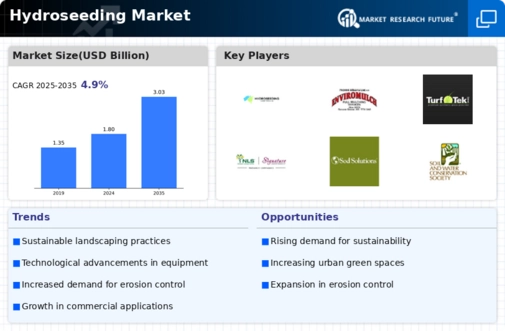Rising Demand for Erosion Control
The increasing awareness regarding soil erosion and its detrimental effects on the environment appears to be a primary driver for the Hydroseeding Market. As urbanization accelerates, the need for effective erosion control measures becomes more pronounced. Hydroseeding offers a viable solution, as it not only stabilizes soil but also promotes vegetation growth. According to recent data, the erosion control market is projected to grow at a compound annual growth rate of approximately 6.5% over the next few years. This growth is likely to bolster the demand for hydroseeding services, as municipalities and construction companies seek sustainable methods to mitigate erosion. Consequently, the Hydroseeding Market is positioned to benefit from this trend, as more stakeholders recognize the importance of maintaining soil integrity in various projects.
Government Initiatives and Regulations
Government initiatives aimed at promoting sustainable land management practices are influencing the Hydroseeding Market. Various regulatory frameworks encourage the use of eco-friendly methods for land restoration, which includes hydroseeding as a preferred technique. For example, policies that mandate erosion control measures in construction projects are likely to drive demand for hydroseeding services. Recent statistics indicate that government spending on environmental restoration projects is expected to rise, potentially reaching billions in the coming years. This increase in funding may create opportunities for hydroseeding contractors and service providers, as they align their offerings with regulatory requirements. Consequently, the Hydroseeding Market is expected to experience growth as stakeholders respond to these governmental incentives and regulations, fostering a more sustainable approach to land management.
Increased Focus on Sustainable Practices
The growing emphasis on sustainable landscaping practices is significantly influencing the Hydroseeding Market. As environmental concerns gain traction, consumers and businesses alike are seeking eco-friendly solutions for land restoration and landscaping. Hydroseeding, which utilizes a mixture of seed, mulch, and water, minimizes the need for chemical fertilizers and pesticides, aligning with sustainable practices. Market data suggests that the sustainable landscaping sector is expected to expand, with a projected growth rate of around 7% annually. This trend indicates a shift towards more environmentally responsible landscaping methods, thereby enhancing the appeal of hydroseeding as a preferred choice for both residential and commercial applications. The Hydroseeding Market stands to gain from this increasing demand for sustainable solutions, as it offers an effective means of establishing vegetation while preserving ecological balance.
Technological Innovations in Hydroseeding
Technological advancements in hydroseeding equipment and techniques are likely to serve as a catalyst for growth within the Hydroseeding Market. Innovations such as improved seed mixtures, advanced spraying technologies, and automated application systems enhance the efficiency and effectiveness of hydroseeding processes. For instance, the introduction of hydroseeding machines equipped with GPS technology allows for precise application, reducing waste and ensuring optimal seed distribution. Market analysis indicates that the hydroseeding equipment segment is projected to witness a growth rate of approximately 5% over the next few years. This technological evolution not only improves the quality of hydroseeding applications but also attracts new customers who seek reliable and efficient solutions for their landscaping needs. As a result, the Hydroseeding Market is poised to benefit from these advancements, which may lead to increased adoption rates across various sectors.
Growing Urbanization and Infrastructure Development
The rapid pace of urbanization and infrastructure development is a significant driver for the Hydroseeding Market. As cities expand and new construction projects emerge, the need for effective landscaping and erosion control becomes increasingly critical. Hydroseeding provides an efficient solution for establishing vegetation in challenging environments, such as slopes and disturbed soils. Market projections indicate that the construction industry is set to grow, with an estimated increase of around 4% annually. This growth is likely to create a heightened demand for hydroseeding services, as developers and contractors seek reliable methods to enhance the aesthetic appeal and environmental sustainability of their projects. The Hydroseeding Market is thus positioned to capitalize on this trend, as it offers a practical approach to addressing the landscaping needs associated with urban development.

















Leave a Comment